****Last updated on13th August 2021****
I regularly review this blog, even though it was first published ages ago. The reason why I don’t update this blog for new sunscreens, is because I haven’t found any that make this list. Having reviewed hundreds of sunscreens now, I just don’t feel the need to tinker with this list.
******
Original blog (dated Aug 2020)
One of my most read blog pages is “Top 5 sunscreen recommendations,” that focuses mainly on sunscreens available in India.
Since then, I have written close to one hundred blogs just on sunscreens and looked at hundreds of sunscreen labels. I hope you’ll agree that my “top sunscreen list” needs an upgrade.
Also, I am an independent, non-affiliated skincare blogger and I have realised that not being influenced by anyone or any product, allows me to give you the unfiltered, honest truth about products.
That makes my value-add to you, priceless.
My sunscreen philosophy
Sunscreen is a way of life for me. I try and use it every day for two reasons. First, prevention against the following damages from over-exposure to UV radiation.

Second, I don’t want to spend the national GDP equivalent on skincare or in the future, cosmetic procedures. I don’t.
Therefore, all the sunscreens that make this list provide formidable protection against UVA radiation to delay the onslaught of ageing skin.
Your sunscreen should reach for the stars or the Chandrasekhar limit. Whichever floats your boat.
Ultrasun Face Anti-Pigmentation SPF 50+
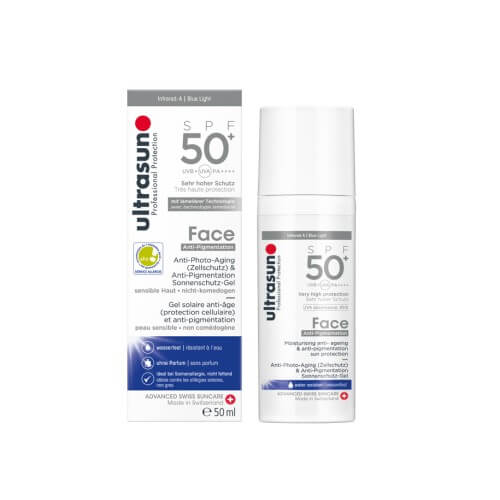
Available online at Marks & Spencer UK website- This is my every day sunscreen and it is the “Gucci” of sunscreens according to me.
- It leaves no whitecast and blends easily.
- It has limited availability globally.
- Price: GBP 32 for 50ml.
Bioderma sunscreens
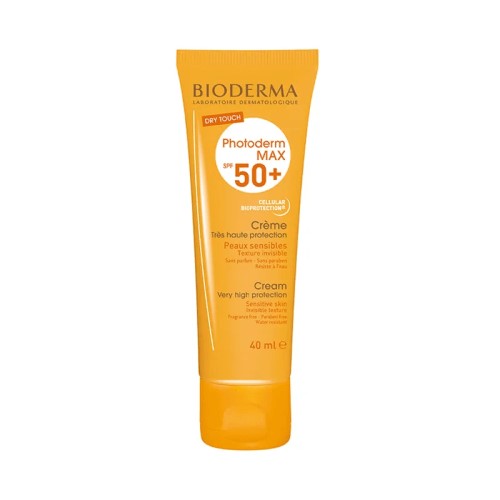

Available online at Nykaa, Boots online pharmacy- Used both sunscreens as my every day sunscreen (pre Ultrasun). I used the SPF 30 when the Photoderm SPF50+ was unavailable.
- Neither leaves a whitecast and blends easily.
- Not available in the USA.
- Price:
- SPF 30 is GBP 15 (UK), ₹1,550 (India)
- SPF 50+ is GBP 15 (UK), ₹1,345 (India).
- Read my review of the Bioderma AKN SPF 30 fluid.
Avene emulsion SPF 50+

Available online at Nykaa, Boots online pharmacy- Offers better protection against UVA radiation then Bioderma above.
- Is drying and does leave a slight whitecast if you don’t spend time blending it in.
- Not available in the USA.
- Price: ₹1,750 for 50ml (India), GBP 18 for 50ml (UK)
- Read my review of Avene emulsion SPF 50
Lakme SPF 50 PA++ Ultra Matte
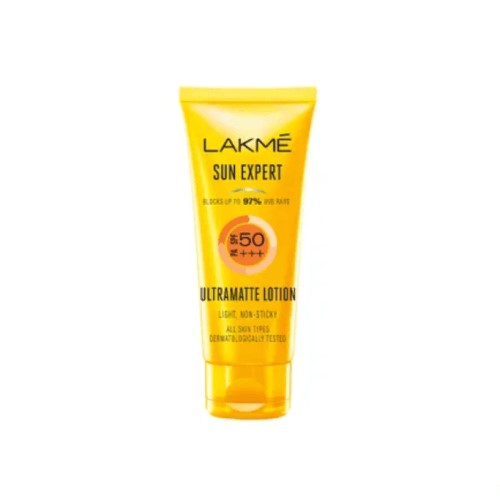
Available online at Nykaa- Offers good UVA protection, which so few Indian sunscreens do
- The smell is chalky and takes some getting used to
- This is the cheapest sunscreen I would suggest
- Generally unavailable outside India.
- Price: ₹280 for 50ml
- Read my review of Lakme Sun Expert SPF 50 PA+++ Ultra Matte
RoC Soleil
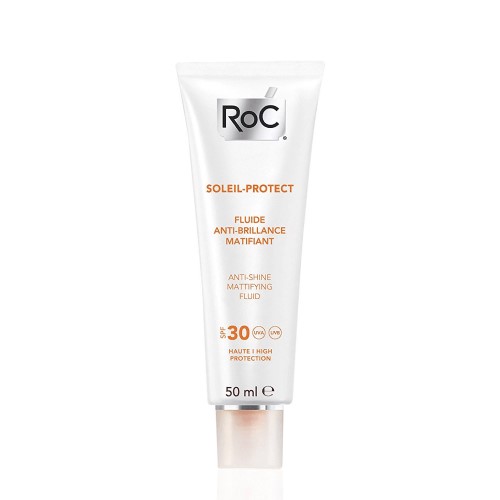
- Offers good UVA protection and is one of the few cheap sunscreens in India that do so.
- Is currently unavaible online in India.
- Price: ₹625 for 50ml on Flipkart
- Read my review of RoC Soleil-Protect Mattifying fluid SPF SPF 30
La Roche Anthelios Ultra Light SPF 30

- Both SPF 30 (PPD 46) and SPF 50+ (PPD 46) provide extremely effective protection against UVA radiation (see below).
- I have used this product intermittently in the past but I find it drying (the second ingredient is Alcohol), but that shouldn’t concern you if you don’t have dry/normal skin
- Price: £17.50 in the UK. Is available in India, but pricing varies too much!
- Read blog What is PA+++? for more information on PPD rating.

Forest Essentials’ sunscreen fluid SPF 50

- In the past two months, my review of this product is my most read blog. It would appear that all of my readers are rushing out to buy this! I can understand why this is the case – its under 1,000 and it leaves no white cast. It also smells extremely pleasant and feels light on the skin. It lets your skin breathe, which is absolutely vital in the crushing heat of an Indian summer.
- I don’t use this product and I won’t be using it because there are products in the market that offer formidably better protection against UVA radiation than this sunscreen. Period.
- Available for sale at Forest Essentials, that does worldwide shipping.
- Price is Rs 975 for 50ml
- Read my review of this product HERE
Innisfree Intensive Anti Pollution Sunscreen SPF50+
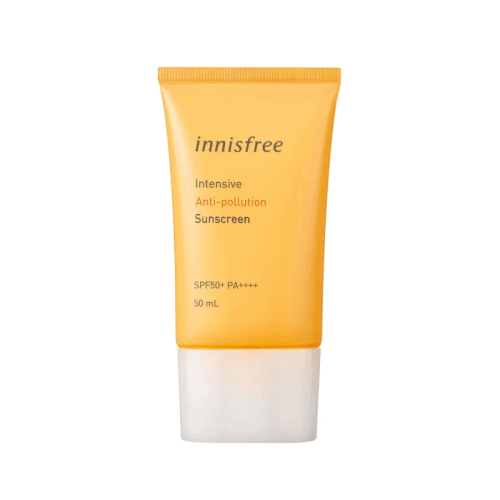
Available at Nykaa- Recently I tried Innisfree’s SPF 35 sunscreen during the lockdown. I ran out of sunscreen. And on the third day, I loved it. The SPF 35 has a strong citrus smell and I stand by my view that it offers moderate protection against UVA radiation.
- BUT its completely fine to wear indoors especially because it blends in so well. I wouldn’t use this if I were outside, preferring instead the SPF 50 version. The SPF 50 version does provide very good protection against UVA radiation.
- Price: ₹1250 for 50 ml
- Read my review of SPF 50 and SPF 35
SunBum Mineral Moisturizing Sunscreen SPF 50

- This is the only Zinc Oxide sunscreen that I could use every day.
- It has a faint coconut fragrance and even though it has Zinc Oxide at 20% its moisturising and does not leave a white cast.
- Limited availability outside the USA.
- Price: USD 15 for 88ml
- Read all about Zinc Oxide benefits at this blog
Supergoop! Unseen sunscreen SPF 40
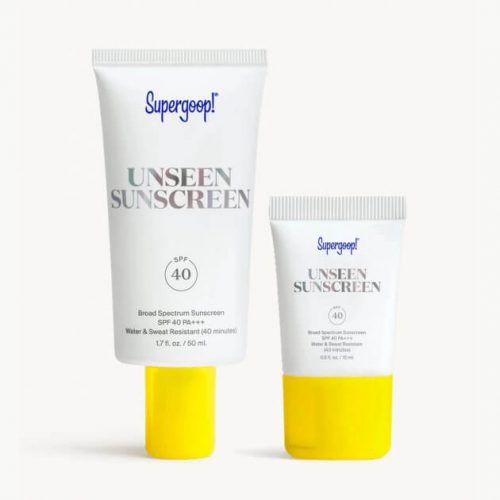
- Ordinarily, I wouldn’t even bother with this sunscreen, but there are so few American sunscreens that do not contain Oxybenzone AND do not leave a whitecast, that this has to make my list. And I’ll be the first one to admit this does not provide the best protection against UVA radiation compared to most other sunscreens on this list…
- Price: USD 34 for 50ml. Available also on cultbeauty.com with worldwide shipping.
- Read my review of this sunscreen here.
And finally, last but not least….Altruist SPF 50

- This is what all sunscreens should be: cheap.
- It is the number bestseller on Amazon UK, so the brand really does not need me to promote it.
- The sunscreens of this brand provide very good protection against UV radiation. Read my review here.
- I have not personally used this product and it gets a lot of mixed reviews because of its texture and application. However, it is cheap enough for everyone to try. The 100 ml tube is available for sale on Amazon UK at £4. This is US$ 5 or INR 375.
Copyright 2020
I wish to remind some of you that I am a non-affiliated skincare blogger. I invest my time, money, blood, sweat, and tears in creating content for my blog. My blog is read in multiple countries and according to my lawyers, each of those countries protects my content and rights under copyright law. If you would like to use my content, do the right thing, and write to me at email@happyskindays.com. Don’t be that person who steals content, because it’s arrogant, disrespectful, and ultimately, a crime.
*****
1. Five products to buy
- seba med Multi-Protect Sun Lotion SPF 50+
- Bioderma Photoderm AKN Mat SPF 30 Matifying fluid
- RoC Soleil-Protect Anti-Shine Mattifying fluid SPF 30
- Avene Emulsion SPF 50+ (very high)
- Dermalogica super sensitive shield SPF 30
In a nutshell, the main reasons for suggesting these products are:
- SPF on each product is at least 30
- Combination of the UV filters and their likely quantity in the product, indicate the product in question provides adequate UVA protection
- Most of the products are made in the EU or have identical composition to the same product that is sold in the EU and therefore, when such products carry the letters “UVA” in a circular logo, this indicates to me that at one-third of the sun protection is towards protection from UVA rays.
2. Observed trends
- All of the 5 products use a surprisingly similar combination of ingredients and this is best illustrated by the featured image. The inference I draw from this is that achieving a photostable sunscreen composition that provides adequate UVA protection is not only EXPENSIVE but also notoriously difficult.
- Sun protection worth buying in India comes at a price. This is graph shows the actual price/gram of the good stuff.
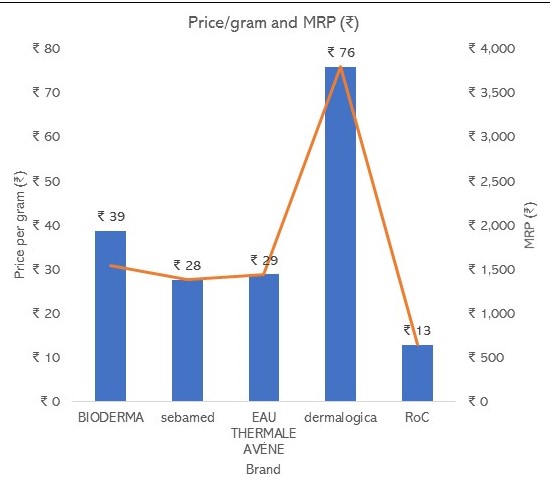
3. Guidelines (methodology)
The section “My thoughts” reflects on these questions
- Are UVB and UVA filters present? If yes,
- Are the filters present in sufficient quantity?
- To satisfy this criteria, the ingredient has to be in the first 7 ingredients listed as (generally) ingredients are listed in descending order of concentration.
- Looking at ALL the filters together, does it appear that they are present in sufficient quantity to provide UVA / UVB protection
- Is the product made in India? If so, I am extremely sceptical of any logos displayed on the product and I largely ignore them.
- Is the product made in the EU? The EU provides that one-third of the sun protection (above SPF 6) should relate to UVA protection. The EU is a good standard to measure all products under review.
- If so, does it carry the letters “UVA” in a circular logo? This gives me assurance that at least one-third of the protection is towards UVA. If the logo is missing – as is the case with Clinique mineral sunscreen fluid for face SPF 50, then I am not satisfied that the product provides sufficient UVA protection.
- Does the product have the Protection Grade of UVA (PA) sign? (see below for more details). I am looking for at least PA+++.
4. INCI names appear on labels
All sunscreen active ingredients appear by their INCI name (and not the common name) that I have used. (There are many other names for these ingredients, NONE of which appeared on packaging….)
- UVB Filters
- Octocrylene (common name = INCI name)
- Octinoxate (common name) is Ethylhexyl Methoxycinnamate (INCI name)
- Diethylhexyl Butamido Triazone (common name = INCI name)
- UVA Filters
- Avobenzone (common name) is Butyl Methoxydibenzoylmethane (BMDM) (INCI name)
- Biscotrizole (common name) is Methylene Bis-Benzotriazolyl Tetramethylbutylphenol (MBBT) (INCI name)
- Bemotrizinol (common name) is Bis-Ethylhexyloxyphenol Methoxyphenyl Triazine (BEMT) (INCI name)
- Diethylamino hydroxybenzoyl hexyl benzoate (common name = INCI name)
- UVB/UVA Filter
- Titanium Dioxide (common name = INCI name)
- Zinc Oxide (common name = INCI name)
5. Importance of regulation
a) EU and UVA protection
Under EU rules, the UVA protection for each sunscreen should be at least a third of the labelled SPF. A product that achieves this requirement will be labelled with a UVA logo, the letters “UVA” printed in a circle.
Permitted EU labels are: Low protection (SPF 6, SPF 10), Medium protection (for SPF15, SPF 20, SPF 25), High protection (for SPF 30, SPF 50) and Very high protection (for SPF 50+)
b) India and lack of additional regulation
In India, a list of permitted UV filters (that’s lifted from EU rules) is implemented into regulation. Sunscreens are regulated as cosmetics and apart from general cosmetic requirements (e.g., labelling should be correct) there is no additional requirement by reason of the product being a sunscreen. For example, “sweat-proof” is found on kaya products and sweat proof is not permitted in the EU OR the USA because its misleading. Similarly, there is no requirement for imported sunscreens from South Korea/Europe and so on, to meet specific UVA targets. There is no additional testing to check that SPF 50 provides UVA protection -and this is a problem because in the US, many products of high SPF have been found to have inadequate UVA protection. Therefore, I have come up with my own guidelines which I apply in every single product review for sunscreens.
c) Japan and the PA system for UVA
The Japan Cosmetic Industry, adopted a rating system for UVA – which from the translated version of the Japanese Cosmetic Industry Association page – appears to be voluntary.
The Protection Grade of UVA (PA) system is based on the Persistent Pigment Darkening (PPD) method which uses UVA radiation to cause a persistent darkening or tanning of the skin. The PA sign is commonly seen on Asian sunscreens.
This is from the JCIA website
PA represents the protective effect of UVA based on UVA’s response to dark skin in a short time (sustained-type immediate darkening) as an index; Is displayed as either “PA +++” (very UVA prevention effect) or “PA ++++” (very high UVA prevention effect), the more “+” numbers, the more UV-A prevention effect It shows that it is high.
https://www.jcia.org/user/public/uv/glossary
P.S. Its important to remember that when products carrying any such signs – PA++ or the letters UVA in a circular logo – are imported into India they are not independently verified by the Indian government.
Sources and uses: IS 4707-2 (2009): Classification for cosmetic raw materials and adjuncts, Part 2: List of raw materials generally not recognized as safe for use in cosmetics [PCD 19: Cosmetics], Annex D: List of U.V. filters allowed in sunscreen products, https://www.jcia.org/user/public/uv/glossary,http://www.bad.org.uk/shared/get-file.ashx?id=3917&itemtype=document
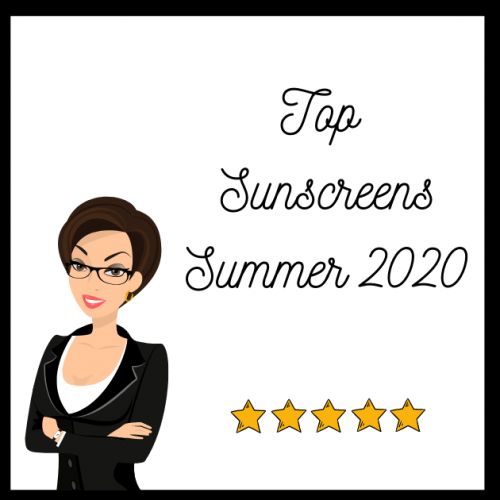
8 thoughts on “Top 5 sunscreen recommendations”
Hi,
I recently came across your blog and I appreciate your outlook on skincare. I would really like to know your take on sunscreen application, amount to be applied and the frequency of application (if there is a blog already, I apologise I wasn’t able to find it )
Thank you
Hi Saumya – there are a few blogs on this. I am travelling at the moment, and if you will bear with me, I will reply as soon as I can. With regards, Angeli
Hi Saumya
Thanks. I have written many blogs on this, but there is always space for more!
1) What do I do every day?
I wear sunscreen first thing in the morning. I will reapply at least once between 1pm-3pm. If I am stepping out, I will also reapply. I use a minimum of 1 tsp for my face and then extra for my neck. (This works a bit more than 2mg/cm2 but that’s fine). I never remember to do my ears
(SPF is calculated under very precise conditions, which translates into using 2mg/cm2).
This is a blog on how this exponentially decreases amount of SPF (and likely UVA) protection afforded by the sunscreen
https://happyskindays.com/difference-between-spf-15-and-spf-50/
https://happyskindays.com/do-i-need-to-wear-sunscreen-now-especially-during-a-lockdown/
2) The official advice
There is conflicting advice (given by the US and Australian regulators). I follow the Australian guidelines because they take sun protection extremely seriously in that country.
This is the guidance provided by the Australian Cancer Council (available online), which should answer your other queries:
1) Sunscreen should be applied 20 minutes before exposure to UV
2) For an adult, the recommended application is 5ml (c. one teaspoon) for each arm, leg, body front, body back, face (including next and ears)
This equates to 35ml (or 7 teaspoons) for a full body application
3) Sunscreen should always be reapplied at least every 2 hours irrespective of the water resistance of the sunscreen
4) Swimming, sport, sweating and towel drying can reduce the effectiveness of the product, so sunscreen should always be reapplied after these activities.
Hi, great post. Could you tell me why you say avene sunscreen has better uva protection than bioderoma one.as far as I know bioderma has ppd of 42.avene doesn’t provide ppd rating right
Hi Radhika, many thanks for your kind words. I am incapable of writing a short response on such a great question!
My blog is confusing, as I am referring to the SPF 30 product (Bioderma AKN SPF 30) which has lower UVA protection than Avene’s SPF 50.
As both Bioderma and Avene are made in the EU, they are subject to EU regulation and I can be sure of a few things:
i) To carry an “SPF 50+” label, the sunscreen must be at least an SPF 60.
ii) Point (i) is important, as EU regulation requires that The minimum UVA protection is at least 1/3 of the SPF.
As the SPF increases so the UVA protection will also increase. By default the UVA protection afforded by Bioderma’s SPF 30 product will be less than Avene’s SPF 50+ product.
I am going to find my notes/take a closer look at the SPF 50 product from both brands and I will let you know.
My twopence on PPD, as a non-affiliated, independent blogger is this:
i)PPD is a very common measure looked at in Japan and South Korea. In fact I have got numerous request to review Centella Purito’s sunscreen which has ridiculously high PPD. But as I am sure you are aware, there is a lot of controversy around this particular brand of sunscreen (much lower protection in independent studies). Frankly, its easy for me to say that I suspected this now (haha!) but for me, it validates my methodology:
– Look at the sunscreen filters and understanding the UVA and UVB protection they provide in a formulation.
– I can estimate what protection a product takes based on my knowledge of reviewing hundreds of sunscreen, doing a bit of modelling, but the only way to confirm labelled SPF and PPD claims is in a lab.
See also
https://happyskindays.com/sunscreen-product-reading-the-label
https://happyskindays.com/what-is-pa
ii) If you ignore the noise of skincare influencers and listen to the folks who design sunscreens, their advice is consistently this: sunscreen is an imperfect solution to a serious problem (ie skin cancer) and its efficacy depends on (i) applying the correct amount (2mg/cm2) and (ii) regular reapplication.
My view is that it doesn’t matter if you use a slightly lower PPD rated sunscreen, provided you REAPPLY and apply the correct amount.
iii) Not all brands release this data and do not use the same method to measure this. It makes like for like comparison very difficult, especially for Made in India sunscreens, who are not subject to strict regulation as in (e.g.) the European Union or Australia
Hi Radhika I wrote this blog, which I hope you find instructive https://happyskindays.com/bioderma-vs-avene-sunscreen/
Please drop me a line if you have any questions.
Hey! I recently came across your blog and this is the kind of info I’ve been looking for. Ive been learning more about ingredients in my routine and I’m someone who insists on using mineral spfs. However, it’s almost impossible to find one in the US which has the feel of Lotus spf 40 (I can’t use it anymore because of ingredients but it’s hands down the best feel on my skin) but without the harmful ingredients. Can you suggest one in the US? I’ve tried a ton of spfs – the supergoop matte screen (feels tacky) and shisedo spf 50 (super oily, doesn’t layer well with serums) are currently top 2.
Hi JP – thanks for your kind words! There is not much choice in the non-tacky mineral sunscreen department. The best is definitely prevage’s SPF 50 (which is US$68, eeks!). Other alternatives are sunbum mineral sunscreen SPF 50 and in India, I recently came across La Shield Matte Sunscreen which essentially doesn’t have that sticky feel of supergoop (https://happyskindays.com/la-shield-matte-sunscreen-gel-spf-50-pa-product-review). Other’s to choice from are Clinique’s mineral sunscreen and Paula’s Choice moisturizer (although this is too oily).
In terms of applying sunscreen, my suggestion to you is cleanse, tone, put your serums on, moisturise and then wait about 10 minutes before even thinking of putting on your sunscreen. I usually wait about 30 minutes (which not everyone can do) and I also use a light moisturiser and watery serums in the morning – simply because I know they will interfere with my sunscreen
This is a list of all the mineral sunscreens on my blog – I have picked my favourites above https://happyskindays.com/all-the-mineral-sunscreen-you-need-to-know-about/
I hope this helps!